<< Previous | Displaying results 4626-4650 of 6769 for "" | Next >>
Jews from Bulgarian-occupied Macedonia who were rounded up and assembled at the Tobacco Monopoly transit camp in Skopje before deportation to the Treblinka killing center. Skopje, Yugoslavia, March 1943. The Jews of Bulgarian-occupied Thrace and Macedonia were deported in March 1943. On March 11, 1943, over 7,000 Macedonian Jews from Skopje, Bitola, and Stip were rounded up and assembled at the Tobacco Monopoly in Skopje, whose several buildings had been hastily converted into a transit camp. The…
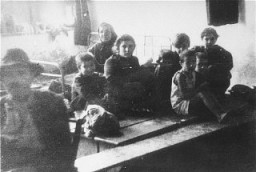
Jews load a barrel of water onto a deportation train in Skopje. In March 1943, Jews of Macedonia were rounded up and assembled at the Tobacco Monopoly in Skopje, where several building had been converted into a transit camp. Bulgarian occupation authorities deported them by train to the Treblinka killing center. Skopje, Yugoslavia, March 1943.
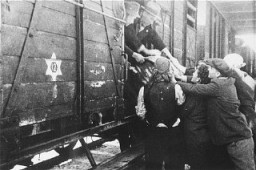
Jews from Bulgarian-occupied Macedonia interned at the "Monopol" tobacco factory, used as a transit camp, before deportation to the Treblinka killing center. Skopje, Yugoslavia, March 1943.
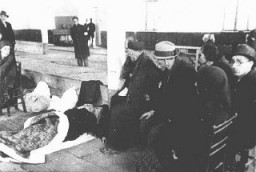
A family of Macedonian Jews carries their luggage down a flight of stairs as they leave the Tobacco Monopoly transit camp for the deportation trains. Skopje, Yugoslavia, March 1943.
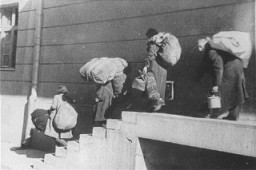
Macedonian Jews leave the Tobacco Monopoly transit camp in Skopje for the deportation trains. Skopje, Yugoslavia, March 1943. The Jews of Bulgarian-occupied Thrace and Macedonia were deported in March 1943. On March 11, 1943, over 7,000 Macedonian Jews from Skopje, Bitola, and Stip were rounded up and assembled at the Tobacco Monopoly in Skopje, whose several buildings had been hastily converted into a transit camp. The Macedonian Jews were kept there between eleven and eighteen days, before being…
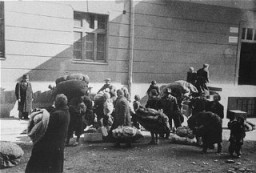
A family of Macedonian Jews in the Tobacco Monopoly transit camp in Skopje before deportation. Skopje, Yugoslavia, March 1943. The Jews of Bulgarian-occupied Thrace and Macedonia were deported in March 1943. On March 11, 1943, over 7,000 Macedonian Jews from Skopje, Bitola, and Stip were rounded up and assembled at the Tobacco Monopoly in Skopje, whose several buildings had been hastily converted into a transit camp. The Macedonian Jews were kept there between eleven and eighteen days,…
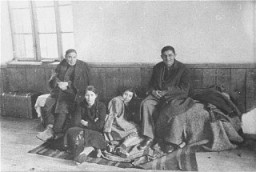
Group portrait of children dressed in Purim costumes. Danzig, 1930-1939.
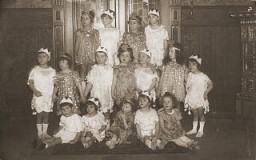
Purim portrait of a kindergarten class at the Reali Hebrew gymnasium. Kovno, Lithuania, March 5, 1939.
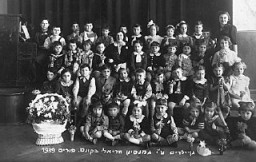
Alice and Heinrich Muller pose for a photograph while in costume for the Purim holiday. Hlohovec, Czechoslovakia, ca. 1934–35.
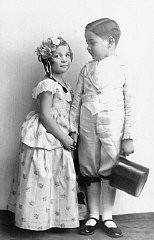
Group portrait of students at the Beis Yaakov religious school for girls dressed in costumes to celebrate the holiday of Purim. Kolbuszowa, Poland, March 1938.
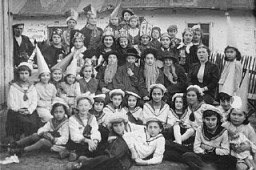
Tom (left) and Wolf Stein (right), dressed in Turkish-style costumes, attend a party celebrating the Jewish holiday of Purim. Hamburg, Germany, 1936.
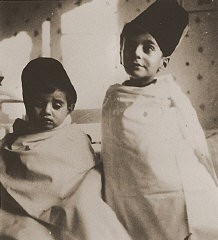
Members of the Chug Ivri (Hebrew Club) in Berlin celebrate Purim with food and song. On the wall is an advertisement for Juedische Rundschau, the newspaper of the German Zionist movement. Berlin, Germany, 1935.
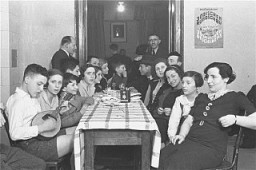
Members of Chug Ivri (Hebrew Club) of Berlin celebrate Purim. While the man in the tallis (prayer shawl) chants the story of Purim from the scroll, a young boy stands ready to use his grogger (noisemaker) to drown out the recitation of the name of Haman, the villain of the story. Berlin, Germany, 1935.
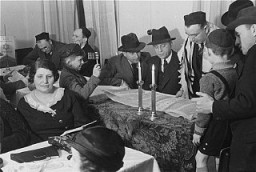
Members of the Chug Ivri (Hebrew Club) in Berlin enjoy a festive meal in celebration of Purim. Berlin, Germany, 1935.
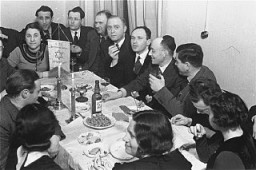
The footbridge over Zgierska Street that joined the two parts of the Lodz ghetto. The street itself was not part of the ghetto. Leon Jakubowicz's model of the Lodz ghetto recreates, on a small scale, the physical appearance of the ghetto, creating the shape of the model to mimic the exact boundaries, streets, and buildings that had a major impact on daily life in the ghetto. Lodz, Poland, ca. 1941. During the Holocaust, the creation of ghettos was a key step in the Nazi process of brutally separating,…
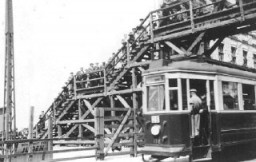
Selma Schwarzwald with her mother, Laura, in Lvov, Poland, September 1938.
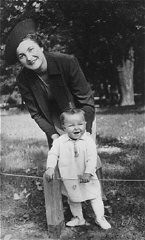
Document issued by the Regional Agricultural Mercantile Cooperative in Busko-Zdroj certifying that Bronislawa Tymejko (the false identity of Sophie Schwarzwald's mother, Laura Schwarzwald) was employed by the cooperative, dated November 1942.
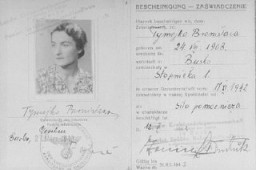
Selma Schwarzwald poses outside while wearing her first communion dress. Selma lived in hiding as a Polish Catholic during the war. Busko-Zdroj, Poland, 1945.
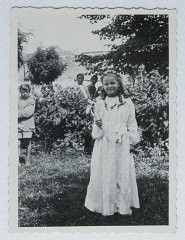
At some point after the war, Sophie received this small stuffed bear (about three inches high) as a present from her mother. She named it “Refugee,” just like she and her mother were refugees of the war.
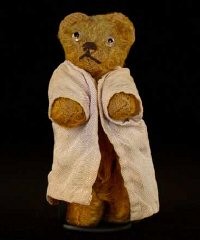
A replica of "Refugee" bear and a photo of a Darfurian child refugee, items taken by Commander Mark Polansky (pictured) on a December 2006 Space Shuttle mission.
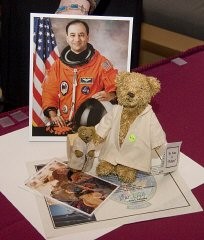
Dr. Sophie Turner-Zaretsky, Space Shuttle Discovery Commander Mark Polansky, and United States Holocaust Memorial Museum chief of staff Bill Parsons. They are holding a replica of "Refugee" bear and a photo of a Darfurian child refugee, items taken by Commander Polansky on a December 2006 Space Shuttle mission.
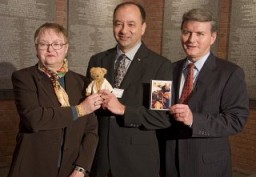
Group portrait of the members of the Zionist pioneer youth group, Ha-Shomer ha-Tsa'ir Hachshara. Kalisz, Poland, May 1, 1935.
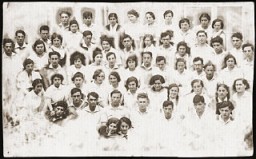
A soccer team of the Jewish sports club, Ha-koach (The Strength). Kalisz, Poland, ca. 1933.
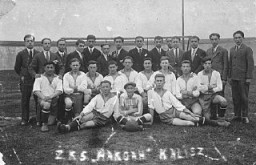
American judges (top row, seated) during the Doctors Trial, case #1 of the Subsequent Nuremberg Proceedings. Presiding Judge Walter B. Beals is seated second from the left. Nuremberg, Germany, December 9, 1946–August 20, 1947.
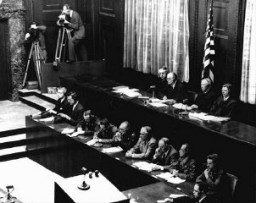
The prosecution team during the Doctors' Trial. Nuremberg, Germany, December 9, 1946-August 20, 1947.
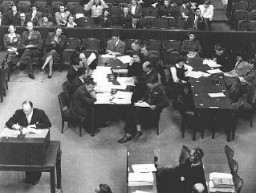
We would like to thank Crown Family Philanthropies, Abe and Ida Cooper Foundation, the Claims Conference, EVZ, and BMF for supporting the ongoing work to create content and resources for the Holocaust Encyclopedia. View the list of donor acknowledgement.